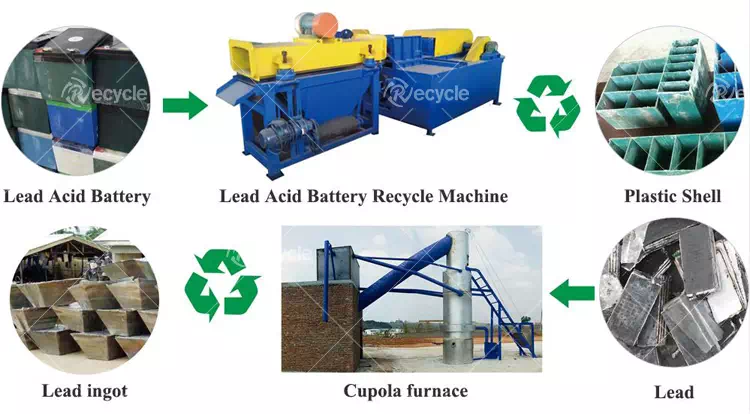News
Lead acid battery recycling and smelting unit process line
Time:2023-09-12 15:03:26
Lead-acid batteries are known for their reliability and affordability and are commonly used in automotive, industrial applications and energy storage systems. But when these batteries reach the end of their useful life, they present both environmental challenges and opportunities for resource recovery. This article will discuss the lead-acid battery recycling smelting unit process line, focusing on related technologies and equipment.
Recycling of lead-acid batteries involves multiple stages aimed at safely dismantling the battery and recovering valuable materials (mainly lead).
1. Collect and organize
The first step in the recycling process is the collection and sorting of used batteries. Batteries are classified according to their type and condition to ensure they go through the appropriate recycling process.
Lead acid battery recycling and smelting
2. Disassembly and separation
Then the lead inside and the plastic casing are completely separated by a fully automatic lead-acid battery disassembly machine. The device quickly separates lead-acid batteries into plastic, acid and lead-containing components. The plastic parts are washed, dried and sent to plastic recyclers. The acid can be neutralized and processed, or converted into sodium sulfate, a product used in laundry detergents, and the lead cocoa can be further refined to produce lead ingots.
3. Smelting
The purified lead solution is then transported to a smelting unit where it is heated at high temperatures to convert the lead material into molten lead. The most common smelting technique is blast furnace smelting, which uses a shaft furnace. This process is energy intensive and requires appropriate emission control systems.
4. Refining
The molten lead is then transferred to a refining kettle where impurities are removed. Depending on the desired purity of lead, the refining process may include desilvering or the removal of bismuth, arsenic and tin.
5. Casting
Finally, the refined lead is cast into ingots, blocks, or specific components for reuse.
Lead-acid battery recycling offers a promising solution to the growing environmental challenge of battery waste. The process enables the recovery and reuse of valuable materials, reducing the need for primary mining and associated environmental impacts.
Although the lead-acid battery recycling smelting unit process line faces challenges, it has huge potential. With the continuous advancement of technology and support from policies, the safe and efficient recycling of lead-acid batteries contributes to resource recovery and a more sustainable battery supply chain. Henan Recyle has extensive experience in recycling technical equipment and recycling of lead-acid batteries. If you have any needs in this regard, please feel free to contact us for consultation.
LATEST NEWS
CONTACT US
Tel: 0086-13674945231(whatsapp)
Email: sunymachine@gmail.com
Add: Henan Communication Industrial Park) 5th St., Economic-Technological Development Zone, Zhengzhou
